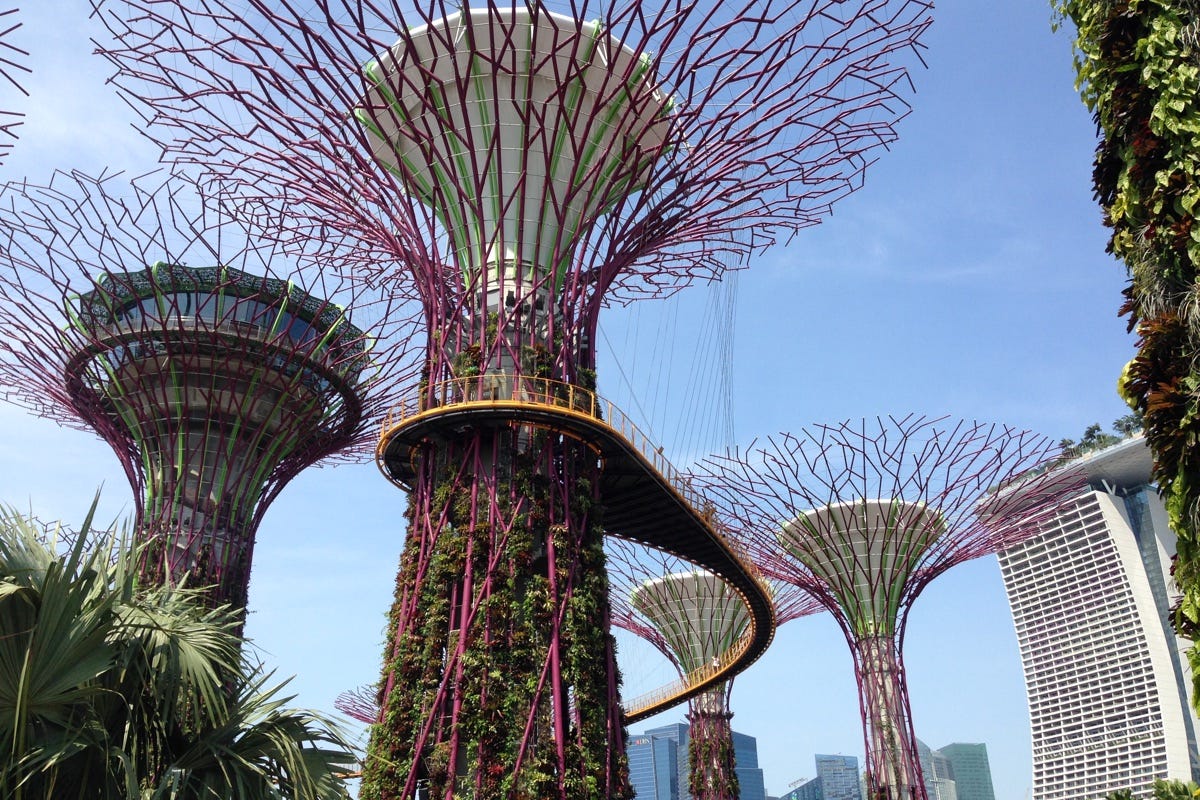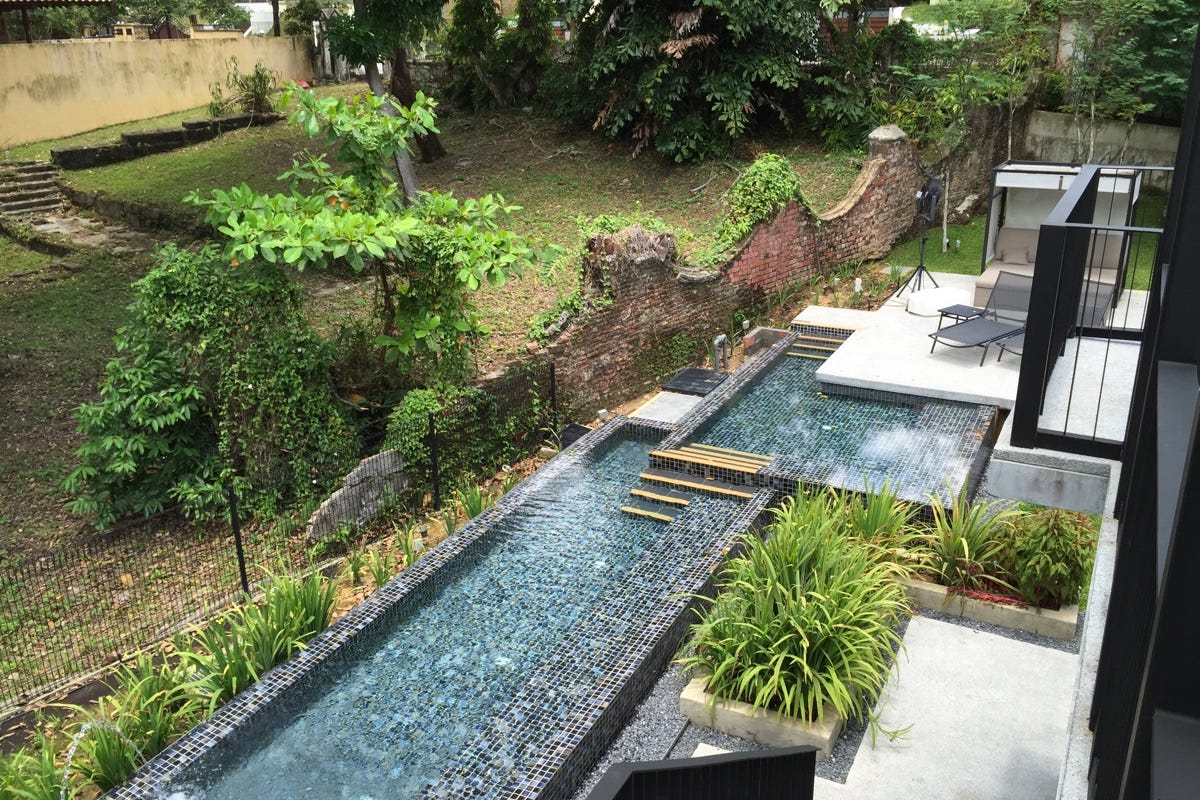A quick word of introduction. My name is Stuart McDonald and this is Couchfish—the perfect tub of ice-cream for the traveller stranded on the couch. The newsletter has both a paid edition which traces a fantasy itinerary through Southeast Asia, and a free one that covers, well, everything else. You’re reading the latter here today, but if you’d like to, you can upgrade your subscription via the button below. Thank you!
I need to head to Singapore next week and given what I’m forever ranting about, I figured I’d try and find a property that was doing things right. Normally I stay in a Chinatown hostel, but thinking perhaps I was missing out, I Googled a bunch of variations on “best eco-whatever in Singapore.” What could go wrong?
For every eco-listicle that Google threw back at me, the Marina Bay Sands was up top, so I decided to peer into that big-spending parallel universe to see what makes one the leader of the hi-so sustainability pack.
Singapore’s very own big banana. Photo: Stuart McDonald.
If you’re not familiar with the Marina Bay Sands, it’s the one that looks like a banana held aloft by three pillars. Opened in 2010, the hotel boasts 2,200 rooms starting at some US$655 a night (on Booking.com), placing it towards the mid- to upper-end of Singapore’s luxury scene. Owned by an American casino company, it features the world’s “largest atrium casino” with 600 tables and 2,300 slot machines.
Anyways, credit where due, the hotel has done quite a bit on the sustainability front. Their Responsible Business Highlights 2022 report makes for an interesting read, and that’s what I’m looking at today. Before I say anything else, I want to note that every hotel on the planet should prepare something like this, though with more context please.
Energy
Thanks to efforts towards more prudent energy use, they’ve saved just shy of 10 million kWh. Great! But how much are they still using? According to the report, they went through 244,425 MWh in 2022. With 2,200 rooms that total works out at around 111 MWh per room per year. Yeah I know they use power for lots of other stuff aside from the rooms, but you can’t have one thing without the other.
If only the nearby Gardens By The Bay generated power like they look like they should. Photo: Stuart McDonald.
Let’s add some context. According to Singapore’s Energy Market Authority, the average use of a one- or two-room house is 175.6 KWh and an apartment 540 KWh. Note the difference—MWH and KWH—convert it and the hotel annual per-room average is around 111,000 KWH. About 600 times that of an average two-room home in Singapore and 200 times that of a private apartment.
An aside. You might note the report mentions that the Marina Bay Sands has a target of 30% renewable energy use by 2025. They’re currently at 21.9%—good to see they’re getting there. Over on Booking.com’s sustainability page for the hotel, they list it as “100% renewable electricity used throughout.” As I wrote last week, Booking’s sustainability reporting effort is a garbage fire. Do not trust a word you read on it.
Water
The hotel’s water use in 2022 was 1,341,002 cubic metres (one cubic metre is one thousand litres), which works out at around 3,600 cubic metres per day. Divide that daily figure by the 2,200 rooms and you get around 1,600 litres per day. Household water consumption in Singapore in 2021 was 158 litres per person. Roughly a tenth of one room at the hotel.
Marina Barrage offers nice views of the joint—it’s also essential to Singapore’s water supply. Photo: Stuart McDonald.
Two things are worth noting here. First, despite how much it seems to rain there, Singapore has a limited water supply. It has four primary water sources—local catchment, imports from Malaysia, reclaimed, and desalinated. The imports represent the largest water source—and thus, for the hotel, an indirect economic leakage. Secondly, Singapore’s Green Plan 2030, aims to reduce household water use to 130 litres per person per day. Dare I say that’s but a drop in the ocean when there are enormous hotels using ten times that.
I want to go to Trash Island
Save a Covid19-induced respite, waste sent to landfill sits around the 10,000 tonnes mark. This sent me down a rabbit hole of Singapore landfill material which I’ve filed away in the “stuff I never planned to learn about” part of my brain. In summary, Singapore seems to have four waste-to-energy plants that contribute around two per cent of their power needs. What can’t be burned, plus the ash residue from what is burned, goes offshore to Pulau Semakau, an island off of the south coast.
A word on Pulau Semakau. It is an amalgamation of two islands Semakau and Pulau Sakeng. The former was home to a small fishing village but the government acquired the land and shifted the residents to mainland HBDs—they must have been thrilled. They even shifted the cats off the island. The islands were then joined and in 1999 the trash dumping began. You can learn more about what the island used to be like here, and old photos here and plenty more here.
On the Marina Bay Sands report, it reads “Waste sent to landfill,” not “Waste burnt in Singapore then buried at sea between two nearby islands that used to be home to fishers who are now living in mainland HBDs.”
While I couldn’t find a figure for household waste, according to the Ministry of the Environment, Singapore generates 8,700 tonnes of waste per day.
Maine Lobsters Rejoice!
The hotel report details steps it has taken to address waste—and all are to be applauded. There’s bamboo toothbrushes—and oddly razors—and they’re trying to get a handle on food waste. They even ditched lobsters from Maine, which is good for the lobsters I guess—and for the carbon involved in flying them around the planet. Despite this, the menus from the hotel’s many restaurants remain awash with imported produce. If you want to drop $300 on 120g of US imported beef, this is the place for you. Again, leakages all over the joint.
Do You Feel Lucky?
The final part of the report looks at the hotel’s social activities. Again, there’s plenty to support here—the Art Science Museum, food kits for Singapore’s more vulnerable, and educational activities. It is worth keeping in mind though that the whole enterprise sits atop an enormous casino—hardly a bastion of upwards social mobility. Indeed Singaporeans are not even allowed into it unless they pay a S$150 daily fee. I wonder why.
What’s My Gripe?
I think it’s important to note at this point that the Marina Bay Sands is doing a lot—far more than many hotels—to mitigate its impacts. My gripe isn’t that they’re not doing enough, I get that this stuff takes time. My gripe is that I don’t see how a property like this will ever be a sustainable undertaking in a tourism sense. While it is important—and helpful—for them to document the steps they are taking, suggesting the end result is going to be an example of sustainable tourism seems to be a stretch to say the least.
On the upside, it is photogenic. Photo: Stuart McDonald.
Let’s skip back to the Chinatown hostel scene for a moment. Where there’s three showers for twenty bunks, no swimming pool and no lobsters from Maine. Where a travellers’ impact is—I’m guessing here—far closer to on par with a local Singapore resident—if not below. Hell, if you’ve ever stayed at Ali’s Nest, you know what I’m talking about!
I’m not suggesting that anyone who cares about sustainable tourism must stay in a hostel. If you’re comfortable being a bit spendy, somewhere like Lloyd’s Inn seems like a good middle ground. I’m guessing here though, as they have nothing about sustainability on their site. Indeed, sometimes it seems the least sustainable have the most to say, so perhaps having no information at all is a good sign!
I guess the core question to be answered here is what does one consider to be a step forward for sustainable tourism? If you go back to its original concept, roughly summarised as “operating in a manner that does not impinge on the future viability of a destination,” then you’d think trying to operate within the framework and limitations faced by local residents seems a decent starting point. Having an undertaking that uses hundreds of times the power and water that residents do, seems less so. As such, I have strong reservations about businesses like this one being reported on in the same breath as “sustainable tourism.” They do not belong there—and they never will.
Lloyd’s always struck me as just a lot more sane. Photo: Stuart McDonald.
I’m not arguing that hotels like the Marina Bay Sands should not exist—I understand their appeal. I get that hotels like this create thousands of jobs and I’m sure the government takes a nice slice off the casino side of things, though I’m less sure of where that dosh ends up—the hotel earned a staggering US$848 million over 2022/2023, with the casino pulling in some 70 per cent of that. I wonder how much of that revenue stays in Singapore. Sustainable tourism needs to be viewed in a holistic manner—at all aspects of the business—economic, environmental and social.
Finding other options—for now—remains a challenge. Travellers like myself who care about sustainability are left using a guess and gut feeling—and I don’t understand why this is the case. Someone needs to fix it, and it sure as hell won’t be Booking or Google.
Me? Back to Chinatown it is.
PS: Regarding last week’s piece on Booking’s sustainability train wreck, I received some feedback suggesting I had been unfair in not soliciting comment from the companies concerned. This is not correct, I did email both Booking and Travalyst, but didn’t hear back from either—but I forgot to mention this in the post. I’ve amended the post the mention this. Thanks again for the feedback.
Couchfish is 100 per cent independent and reader-supported. If you’re not already a subscriber, and you’d like to show your support, become a paying subscriber today for just US$7 per month—you can find out more about Couchfish here—or simply share this story with a friend.
Don’t forget, you can find the free podcasts on Apple, Pocket Casts and Spotify as well as right here on Couchfish.















